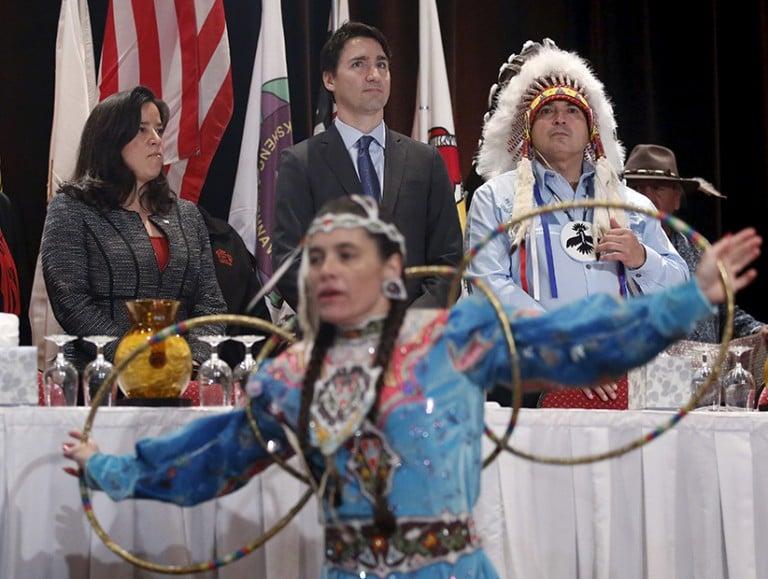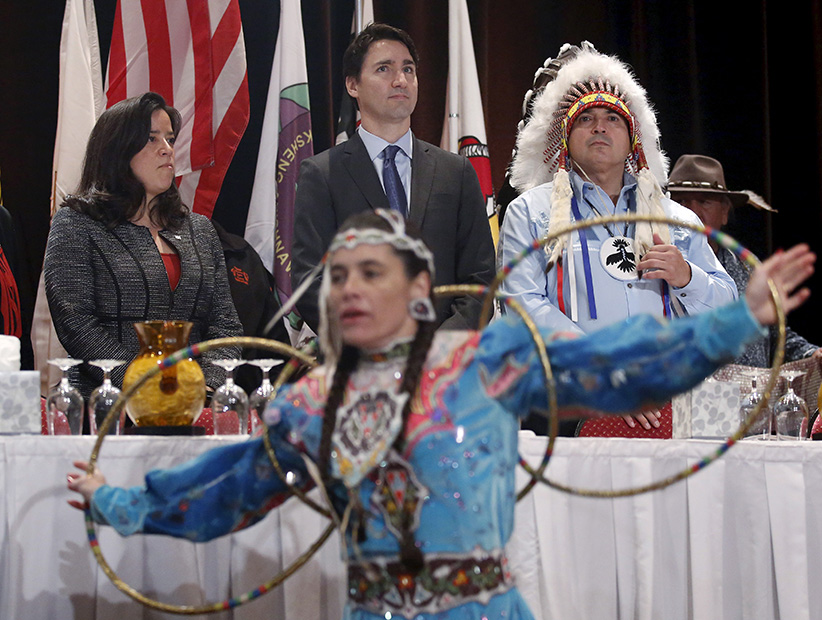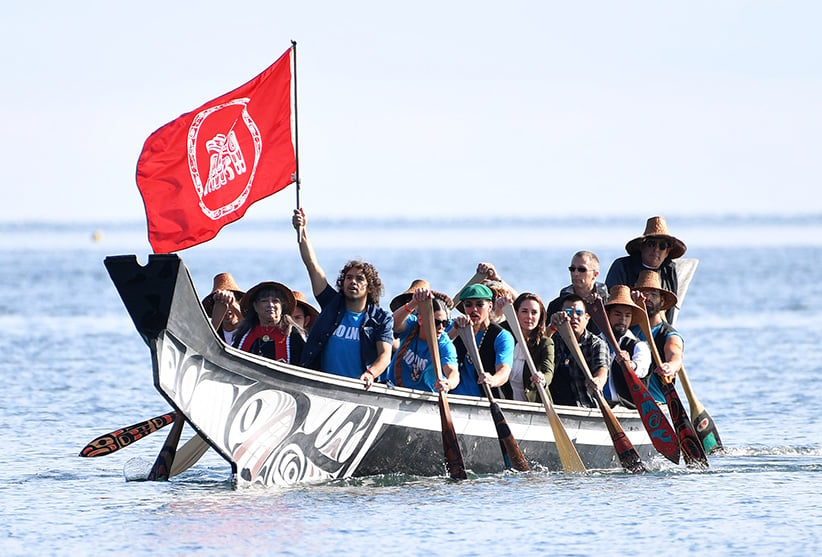The Liberals’ relationship with Indigenous communities sours
Trudeau Report Card: How a new ‘nation-to-nation’ relationship with Indigenous communities quickly fell apart

Canada’s Prime Minister Justin Trudeau (C) stands with Justice Minister Jody Wilson-Raybould (L) and Assembly of First Nations National Chief Perry Bellegarde during an opening ceremony at the Assembly of First Nations Special Chiefs Assembly in Gatineau, Canada, December 8, 2015. (Chris Wattie/Reuters)
Share

A year after a stunning majority win, Maclean’s adds up the stumbles and successes of Justin Trudeau’s government in our Trudeau Report Card. The hard work of delivering on more than 200 campaign promises—and breaking some along the way—has only just begun. Read our analysis of how the Liberals are handling security, immigration, the economy and more in our full Report Card coverage here.
Four moments last month seemed to make clear how much Justin Trudeau cares about his relationship with Indigenous peoples in this country. On Sept. 12, his government’s lawyers squared off in federal court against two First Nations over the $9-billion Site C dam he green-lit in B.C.’s northeast. Ten days later, fury with his government’s tactics in a fishing dispute pushed the Tla-o-qui-aht to bar the Prime Minister from their territories near Tofino, B.C. Four days after that, Trudeau okayed a $36-billion liquefied natural gas (LNG) project near Prince George, B.C., overriding treaty concerns and fears over potential impacts on a nearby salmon run, the second-largest in the country.
When it comes to relations with Indigenous communities, it’s getting pretty hard to figure out what differentiates this government from the one Stephen Harper ran before it. Harder still is squaring Trudeau with the man Indigenous people met on the campaign trail last year—the guy with the roster of First Nations candidates, making heady promises of a new “nation-to-nation” relationship with Indigenous peoples. No issue, Trudeau said at the time, was more important to him. What a difference 12 months makes.
A muggy, midsummer meeting of Assembly of First Nations (AFN) leaders in Niagara Falls, Ont., was the setting of the Trudeau government’s first Indigenous volte-face. One year before the July 12 meeting, almost to the day, Trudeau promised the AFN leadership that if elected, he would implement the United Nations Declaration on the Rights of Indigenous Peoples (UNDRIP).
The Liberals included the promise to enact the international treaty enshrining Indigenous rights to self-determination in their platform. After gaining power, incoming minister of Indigenous affairs Carolyn Bennett reaffirmed that pledge: “We intend nothing less than to adopt and implement the declaration in accordance with the Canadian Constitution.”
Then came July. It fell to Kwakwaka’wakw Justice Minister Jody Wilson-Raybould to drop the bombshell that adopting UNDRIP was, in fact, “unworkable.” She didn’t stop there: “Respectfully, it is a political distraction to undertaking the hard work required to actually implement it,” she said.

This came as news to AFN National Chief Perry Bellegarde, who had celebrated Trudeau’s “unqualified support” for UNDRIP as a “crucial step” in the path to reconciliation. And to Ontario Regional Chief Isadore Day, who’d deemed it a “turning point,” and a “clear signal that will light the way to strengthening the nation-to-nation relationship between Canada and Indigenous peoples.”
It seems the Liberals belatedly recognized, just as Harper had done, that adopting UNDRIP could end up overriding existing constitutional arrangements, and cost the feds dearly. So Wilson-Raybould told AFN leaders that Canada will be backing UNDRIP in spirit, through legislation, “action” and “policy”—whatever that means.
If Trudeau similarly concludes that implementing all 94 “calls to action” in the final report of the Truth and Reconciliation Commission is unworkable, he’ll face the not-inconsiderable wrath of his highest-profile addition to the Senate; it’s doubtful anyone in the country wants to see them implemented more than their author, the universally respected Murray Sinclair.
Just two weeks after the UNDRIP imbroglio, Indigenous leaders found themselves disillusioned with the new government. Trudeau’s go-ahead of B.C.’s Site C dam quashed hopes it might put the project to further review, given its commitment to a new relationship “built on trust, recognition and respect for the rights” of Indigenous communities.
On Friday afternoon of the August long weekend—a window traditionally reserved for announcements governments want to bury—the Liberals issued construction permits for Site C. This allowed the controversial project to continue even as impacted Treaty 8 nations were making arguments against it in Federal Court.
Grand Chief Stewart Phillip, head of the Union of B.C. Indian Chiefs, one of the country’s most influential Indigenous leaders, called the move “an absolute betrayal of all of the commitments and promises” Trudeau made during the campaign. And he called out the yawning maw separating the Prime Minister’s actions from his “lofty public platitudes” about Indigenous relations.
If completed, the Peace River dam and hydroelectric generating station—first approved by Harper in 2014, following findings by a joint review panel that Site C would have a significant impact on First Nations’ use of land and resources—could power half a million homes a year. But that means flooding 23,000 hectares of land in the Peace River Valley, territory that includes sacred burial grounds, medicinal and hunting sites, and 12,000-year-old Dane-zaa historical sites.
That’s why, four years ago, when Wilson-Raybould was B.C. regional chief for the AFN, she campaigned against the mega dam. It ran “roughshod” over “Aboriginal title and treaty rights,” she said. After the about-face, the chief of West Moberly First Nation, which faces territorial destruction as a result of the project, called on her to resign.
“I’ve heard many times this government is serious about doing things different,” Quebec AFN Chief Ghislain Picard said last month, outside the one-day Federal Court hearing on Site C. “This government has to show more seriousness in the way it deals with our people.”
All that came before the Liberals announced they were giving Malaysia’s state-owned Petronas the right to build a massive LNG export terminal on Lelu Island, at the mouth of the Skeena River in northern B.C. Phillip believes the LNG project, which may rival Alberta’s oil sands as one of Canada’s single largest point sources for greenhouse gas emissions, would “decimate” the Skeena salmon fishery.
“We have options—legal recourse, action on the ground,” says Haida President Peter Lantin. “The Haida have never accepted anything as inevitable. You can guarantee the Haida will do whatever they can to disrupt this project.”
The Petronas-led Pacific NorthWest LNG consortium wants to route 19 million tonnes of LNG through B.C., then ship it to markets in Asia. The timing of the Trudeau government’s decision—just before the duke and duchess of Cambridge visited Haida Gwaii on Sept. 30—made the Haida even more angry. “It puts a lot of pressure on us—what are we going to do? What are we going to say?” Lantin asked.
Prime Minister Trudeau, who has a Haida raven tattooed on his shoulder, was not there that day to face to the Haida. Christy Clark, who championed the project, pulled out the night before. Lantin made clear the B.C. premier was asked not to come.

The Haida refused to let that anger upstage the royal visit, but found ways to make their message known. Those paddling Will and Kate to the shores of Graham Island wore bright-blue “No LNG” T-shirts. Along the Yellowhead Highway, a group of anti-LNG protesters stationed themselves at a spot the royal motorcade would have to pass. Anger with the Prime Minister was widespread. “We used to take pride in the Prime Minister’s Haida ink,” said Delvina Lawrence. “We thought he was a friend. Now, it feels like he’s stabbed us in the back.”
It’s unlikely these will be the last harsh words Trudeau hears from the Indigenous community in the years ahead. Many are already pledging to make Lelu Island the next Standing Rock—the massive standoff near the Standing Rock Sioux reservation in North Dakota that aims to halt construction of a new oil pipeline. An Amnesty International campaign against Site C is meanwhile turning the dam into a global human-rights issue. “Indigenous people anywhere in Canada should be looking at this case with great concern,” says Amnesty’s Craig Benjamin.
On other files, however, Trudeau has enough money on the table to make significant progress. He’s earmarked roughly $1.8 billion to try to fulfill his promise to end boil-water advisories in Indigenous communities in five years. He’s launched a long-sought inquiry into murdered and missing Indigenous women and girls. And in last spring’s budget, the Liberals announced plans to spend $8.4 billion over five years on priorities like education and housing to improve the lives of Indigenous people. But real-world events keep reminding him how big these challenges really are.
Indigenous leaders say his government has done virtually nothing to comply with a January Human Rights Tribunal decision that ruled Indigenous kids are discriminated against because of inadequate funding for child and welfare services. The tribunal issued a second compliance order to force the government to rectify funding shortfalls and make sure Indigenous children who live on-reserve have access to the same public services as other Canadian children.
“What they’re doing is illegal and immoral,” said Cindy Blackstock, executive director of the First Nations Child and Family Caring Society of Canada. “We’re talking about little kids.” No surprise then, that Trudeau, on Oct. 10, was treated to his first national Indigenous day of action—Deeds Not Words. “First Nations are waking up to the reality that this government has a big smiley face for a front man,” said a spokesperson. But when it comes down to it, “nothing has changed.”
In sum
In the bag: In March, the Trudeau government earmarked roughly $1.8 billion in funding to end boil-water advisories in Indigenous communities in five years.
In progress: In August, the Liberals launched a wide-ranging inquiry into murdered and missing Indigenous women and children.
In jeopardy: Trudeau’s campaign promise to take “immediate action” to implement the Truth and Reconciliation Commission’s 94 “calls to action.” Twelve months on, Indigenous leaders are still waiting.
Maclean’s complete Trudeau Report Card:
ECONOMY: A sluggish start to delivering on promises
ELECTORAL REFORM: A long way from a breakthrough
CLIMATE CHANGE: After flexing muscle, year two will tell
SECURITY AND MILITARY: Lowering expectations
INDIGENOUS PEOPLE: A relationship sours